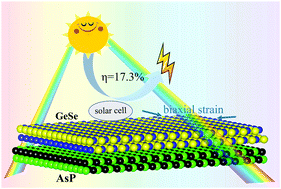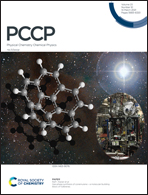The high power conversion efficiency of a two-dimensional GeSe/AsP van der Waals heterostructure for solar energy cells†
Abstract
Constructing a van der Waals heterostructure is a practical way to promote the conversion efficiency of solar energy. Here, we demonstrate the efficient performance of a GeSe/AsP heterostructure in solar energy cells based on the first-principles calculations. The electronic properties, optical absorption, and optoelectronic properties are calculated to evaluate the efficiency of the newly designed heterostructure. The results indicate that the GeSe/AsP heterostructure possesses a type-II band alignment with an indirect bandgap of 1.10 eV, which greatly promotes the effective separation of photogenerated carriers. Besides, an intrinsic electric field is formed in the direction from the AsP to GeSe monolayer, which is beneficial to prevent the recombination of the photogenerated electron–hole pair. Simultaneously, a strong optical absorption is observed in the visible light range. The predicted power conversion efficiency (PCE) of the GeSe/AsP heterostructure is 16.0% and can be promoted to 17.3% by applying 1% biaxial compression strain. The present results indicate that the GeSe/AsP heterostructure is a promising candidate material for high-performance solar cells.



 Please wait while we load your content...
Please wait while we load your content...